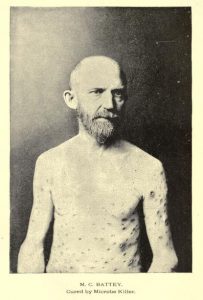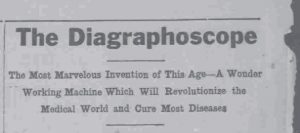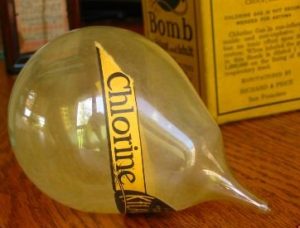Devices and therapies
ADvent Calendar 1: The Health Jolting Chair
Every day until Christmas, The Quack Doctor will be showing a different historical health-related advertisement. First is this brain-refresher and household blessing – the Health Jolting Chair (1885), courtesy of the US National Library of Medicine. . .
Read More10 Victorian products for Movember
As more than a million people across the world spend this month growing moustaches to raise awareness of – and funds for – Movember‘s men’s health projects, here are a few 19th-century products to help them along the way. 1. Latreille’s Excelsior Lotion Advertised in the 1870s by John Latreille, originally of Walworth, this product used […]
Read More
An ulcer as big as a hen-egg
Patient testimonials were (and indeed remain) an integral part of the promotion of non-evidence-based health products. While 19th-century newspaper advertising only had room for concise endorsements, promotional books and pamphlets allowed medicine proprietors to give more detailed case studies of those who had supposedly benefited from their products. This one by Mr M C Battey, […]
Read MoreBailey’s Rubber Complexion Brush
A harmless alternative to the arsenical preparations then in vogue for improving the complexion, Bailey’s rubber brush was intended to improve the circulation, clear the pores and allow the blood to free itself of impurities. Charles J Bailey of Newton, Massachusetts, invented the product in 1887, immediately patenting it in England, France, Canada, Belgium […]
Read More
The Diagraphoscope – a wonder-working machine
Twentieth-century businessman X. W. Witman saw a lot of potential in X-rays. Doctors might get excited about their emerging medical application, but for him X-rays offered something even better – the chance to get rich quick. If you could X-ray Witman’s head, the plate would display a fine collection of dollar signs. Adverts puffed his […]
Read MoreTo Short Persons
TO SHORT PERSONS.——Anyone (Male or Female) wishing to increase in Height and Symmetry of Figure, by means of a remarkable physiological discovery, may send a stamped directed envelope to Captain F. STAFFORD (U.S.). 1, Church-terrace, Kentish Town, London, N.W. The Penny Illustrated Post, 15 October 1870 —————————————————————————– Some advertisements might make wild claims, but as […]
Read More
Bomb the first sneeze with Kilacold
If you think a chlorine bomb sounds more like something from the battlefield than the medicine cabinet, then you’d be right about the origins of this 1920s remedy. The product, and a brief trend among physicians for treating colds with chlorine, arose from experiments made by the US Chemical Warfare Service after the First World […]
Read MoreDr W. S. Rice’s Rupture Method
I had this post all specially planned for 21 May 2011 and now you tell me today has nothing to do with ruptures? Honestly, I don’t know why I bother. Well, I might as well post it anyway – I get the feeling not many Quack Doctor readers will be going to heaven any time […]
Read MoreThe Electropathic and Zander Institute
Regular readers might remember Cornelius Bennett Harness, who carried on a lucrative business in electro-magnetic products in London in the 1880s and 1890s. I have blogged about his Electric Corsets and the Ammoniaphone, an inhaler promising artificial Italian air to singers and public speakers. Harness’s showrooms, known as the Electropathic and Zander Institute, were on […]
Read MoreThe Benefits of Phrenology
In honour of UK Census Day, here’s one way in which phrenology proved of great help in 1891: Source: The Hampshire Telegraph and Sussex Chronicle, 11 April 1891 . .
Read More